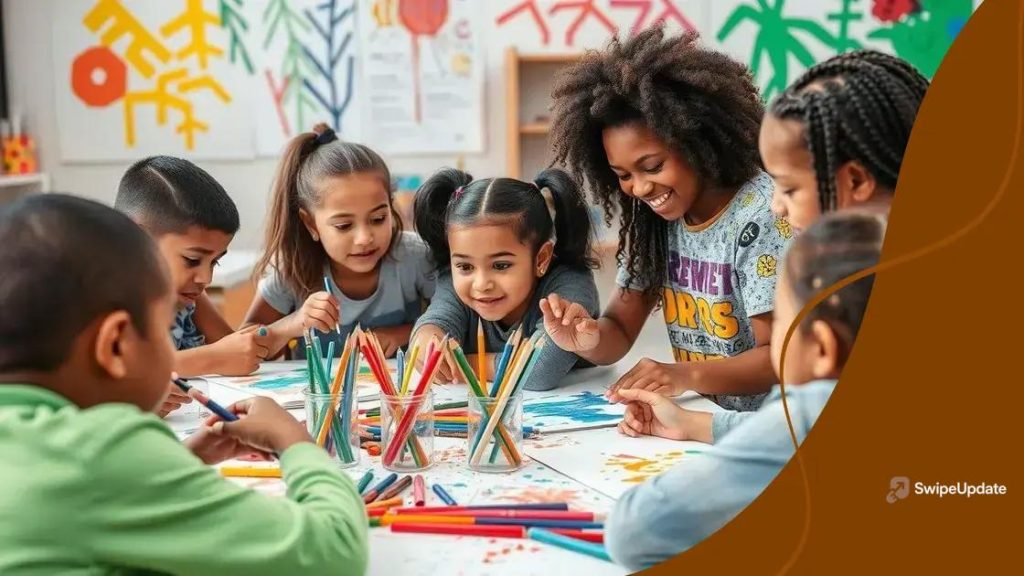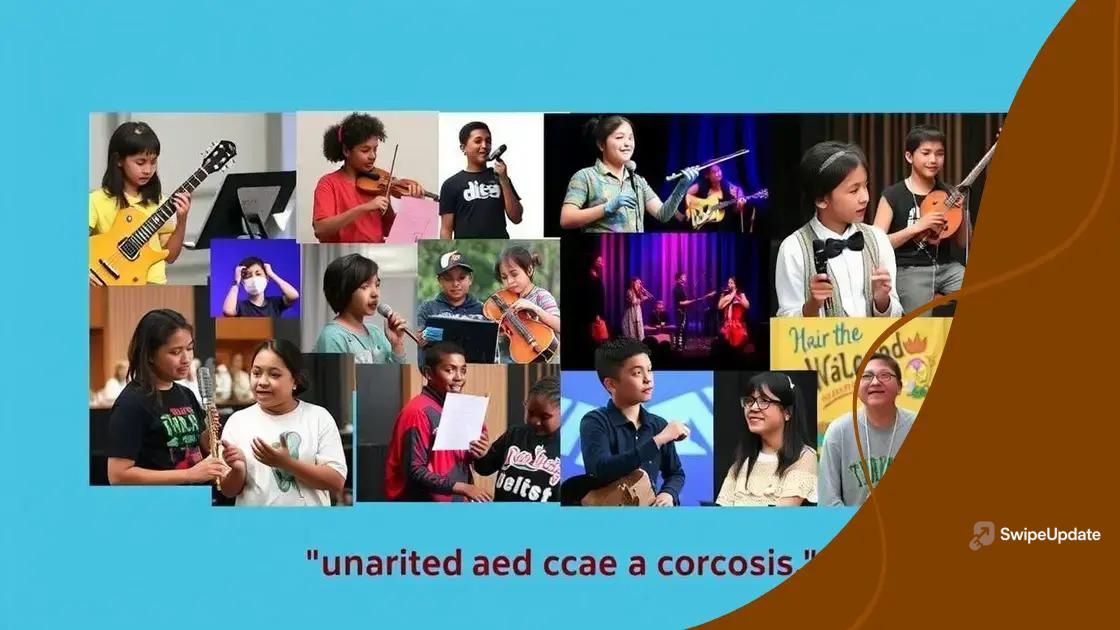Funding for arts education: vibrant futures ahead

Funding for arts education is crucial as it provides essential resources, supports qualified instruction, and fosters creativity, enabling students to thrive academically and socially.
Funding for arts education is more than just numbers; it’s about unlocking potential in students. Have you ever wondered how creative programs transform young minds? Let’s explore the value of investing in arts education.
Understanding the importance of arts education
Understanding the importance of arts education is vital for shaping our future generations. It fosters creativity, critical thinking, and emotional expression in students. In today’s world, these skills are more important than ever.
Arts education goes beyond just creating; it’s about developing a well-rounded individual. Students who engage in arts learn to appreciate different perspectives, which enhances their ability to think outside the box.
Benefits of Arts Education
Investing in arts education leads to numerous benefits. Here are some key points:
- Enhances creativity and problem-solving skills.
- Improves academic performance in other subjects.
- Boosts self-esteem and confidence.
- Encourages collaboration and teamwork.
Studies show that students involved in arts programs outperform their peers in standardized tests. Funding for arts education directly contributes to these positive outcomes.
Critical Thinking Through Arts
Engaging in arts helps develop critical thinking skills. Students learn to analyze and critique their own work and the work of others. This critical engagement promotes a deeper understanding of the world around them.
When students express their thoughts through various mediums, they become more self-aware and empathetic. This emotional intelligence is crucial for their overall development.
Moreover, arts education can serve as a tool for social change. Programs that focus on inclusivity and diversity encourage students to share their stories. This not only enriches their personal experiences but also promotes a sense of community.
Long-Term Impact
The long-term effects of arts education are profound. Students who experience quality arts programs are likely to pursue careers in creative fields, but they also excel in any career they choose. They bring unique perspectives and innovations to their workplaces.
Ultimately, funding for arts education is an investment in our society’s future. By nurturing creativity and critical thinking, we prepare students to tackle the challenges of tomorrow.
How funding impacts creativity
Funding plays a crucial role in how creativity is fostered within arts education. When schools have access to sufficient funding for arts education, they can provide more resources, hire skilled instructors, and offer diverse programs that ignite students’ imaginations.
With increased funds, schools can purchase materials such as paints, instruments, and technology. This access allows students to explore their creativity without limitations. When students can engage with high-quality materials, they feel more inspired and excited about their projects.
Access to Quality Instruction
Quality instruction is a direct benefit of proper funding. When schools can afford to hire dedicated arts educators, students receive guidance from professionals who are passionate about teaching. These educators encourage creativity by exposing students to various artistic techniques and styles.
- Teachers can offer personalized feedback.
- Students learn about art history and cultural significance.
- Workshops and guest artists can be brought into schools.
These elements create a rich learning environment where students thrive and express their unique voices.
Moreover, when funding is allocated for arts education, it often leads to the implementation of innovative programs. Schools can explore new trends in the arts, from digital media to performance art. This variety helps students find their interests, contributing to a more well-rounded education.
Impact on Community Engagement
Increased funding can also strengthen community ties. Schools with robust arts programs often collaborate with local artists and organizations. These partnerships provide students with real-world experiences, further enhancing their creativity.
By participating in community events and exhibits, students gain confidence in their abilities and learn to appreciate the broader impact of their work. Supporting local arts initiatives fosters a sense of pride and belonging among students.
Ultimately, when we prioritize funding for arts education, we empower students to express themselves. Encouraging creativity through adequate resources lays the foundation for innovation, skill development, and lifelong appreciation for the arts.
Success stories of funded arts programs

Success stories of funded arts programs showcase the profound impact that funding for arts education can have on students and communities. When resources are allocated to arts initiatives, the results can be transformative.
One notable example is a public school in California that received funding to enhance its music program. With new instruments and dedicated instructors, students who once struggled found their passion for music. As a result, they not only improved academically but also gained confidence in themselves.
Community Engagement and Empowerment
Another inspiring success story comes from a theater program in New York City. With proper funding, this program provided opportunities for underprivileged youth to explore their talents. Students engaged in workshops, learned from industry professionals, and performed in front of live audiences.
- Participants gained valuable skills in acting and public speaking.
- The program built a sense of community among diverse participants.
- Graduates of the program often return as mentors.
This experience not only boosted their resumes but also empowered them to aspire to careers in the arts or related fields.
In another case, a visual arts program in a rural area benefited significantly from funding. Students had access to high-quality art supplies and technology that allowed them to create stunning projects. Their works were featured in local galleries, showcasing their talent on a larger stage.
A Pathway to Higher Education
These success stories demonstrate how funding for arts education opens doors to higher education. Many students from funded programs have gone on to qualified colleges, pursuing degrees in fine arts, music, and design.
One student reported that her experience in a funded visual arts program inspired her to apply for art school. She credits the program for developing her skills and confidence, which helped her secure a scholarship.
These stories confirm that when we invest in arts programs, we are investing in the future of our youth. Every dollar spent on the arts has the potential to change lives and strengthen communities.
Challenges in securing funding
Challenges in securing funding for arts education can hinder the growth and sustainability of vibrant programs. Many schools and organizations face obstacles that prevent them from obtaining the financial support they need.
One of the primary issues is the competition for limited funds. Schools often compete for grants and donations, which can create barriers to accessing resources. Many promising arts programs struggle to make their case when compared to other educational initiatives.
The Impact of Budget Cuts
Another significant challenge is the impact of budget cuts on arts education. When school districts face financial deficits, arts programs are often the first to suffer. This leads to reduced class offerings and even program cancellations, affecting students’ creative development.
- Students may lose valuable opportunities to explore the arts.
- Experienced teachers may be laid off, impacting the quality of education.
- The community may become less engaged in the arts due to fewer available programs.
These cuts can have long-lasting effects, as schools that minimize arts education may struggle to revive programs once financial conditions improve.
Awareness and Advocacy
Increasing awareness and advocacy for the importance of arts education is essential. Many decision-makers may not fully understand the benefits of funding for arts education. This lack of understanding can lead to undervaluing these programs, making it harder to secure necessary funds.
Advocacy groups play a crucial role in increasing support for funding. They work to educate the public and policymakers on the significance of arts in fostering creativity, critical thinking, and collaboration among students.
However, advocacy efforts need to be consistent and well-organized to make a tangible impact. Without a unified voice, it is challenging to influence decisions and secure adequate funding for arts programs.
Overall, addressing these challenges is necessary to ensure that arts education continues to thrive and inspire future generations. By overcoming funding obstacles, schools can provide students with the creative opportunities they deserve.
Future trends in arts education funding
Future trends in arts education funding reflect a growing recognition of the importance of creativity in learning. Schools and organizations are beginning to understand that investing in arts education is not just beneficial; it is essential for developing well-rounded students.
One emerging trend is the shift toward integrating arts with other subjects. This interdisciplinary approach attracts more funding as it demonstrates how arts can enhance learning in core subjects like math and science.
Leveraging Technology
Advancements in technology are also shaping the future of funding for arts education. Schools are increasingly utilizing digital tools to enhance the arts curriculum. Virtual reality, digital media, and online platforms can reach a wider audience and engage students in innovative ways.
- Technology can reduce costs for materials and supplies.
- Online platforms create opportunities for collaboration among students from different backgrounds.
- Virtual workshops can invite professional artists to share their expertise.
These advancements not only improve access to arts education but also attract funding from tech-oriented organizations and grants.
Community Partnerships
Another trend involves building strong community partnerships. Many schools are collaborating with local arts organizations, museums, and cultural institutions. These partnerships can provide additional resources and funding, enhancing the arts experience for students.
Through community engagements, students can participate in real-world projects, gaining hands-on experience and skills that go beyond the classroom. As these partnerships flourish, the demand for funding increases, encouraging longer-term investments in arts education.
Overall, the landscape of funding for arts education is evolving. As more stakeholders recognize the vital role of creativity in student development, we can expect to see increased financial support for arts programs, ensuring that the arts remain a central part of educational curricula.
FAQ – Frequently Asked Questions about Funding for Arts Education
Why is funding important for arts education?
Funding is essential for providing resources, qualified instructors, and innovative programs that enhance creativity and learning in students.
What are some challenges in securing funding for arts programs?
Challenges include budget cuts, competition for limited funds, and a lack of awareness about the benefits of arts education.
How can community partnerships help arts education funding?
Community partnerships can provide additional resources and support, helping to create engaging programs and broaden opportunities for students.
What future trends should we expect in arts education funding?
Future trends include interdisciplinary approaches, leveraging technology, and growing community collaborations that attract more funding for arts programs.
